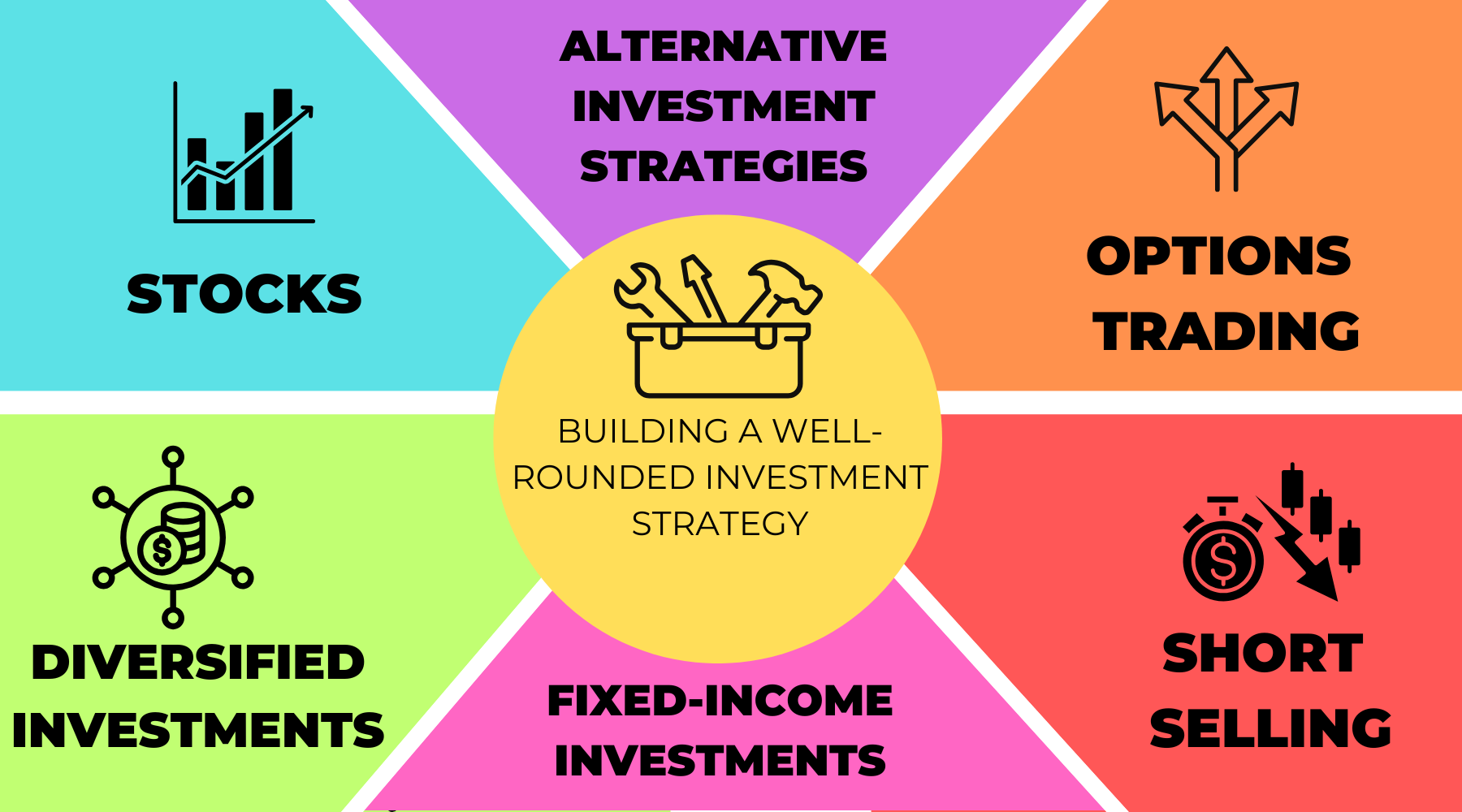The Investor’s Toolkit: Understanding Stocks, Shorting, Options, and Fixed-Income Strategies

Building a Well-Rounded Investment Strategy
Developing effective investment strategies is crucial for managing risk and maximizing returns. Whether your goal is long-term wealth accumulation, short-term gains, or portfolio protection, using a mix of strategic approaches can improve success. By understanding different investment strategies, investors can navigate market fluctuations and build a resilient portfolio.
Key Investment Strategies and Asset Classes
1. Stocks: A Core Component of Investment Strategies
Stocks are a fundamental part of most investment strategies, offering strong growth potential but also increased volatility. Investors use various methods to manage risk while taking advantage of long-term market trends.
Types of Stocks:
- Growth Stocks – Companies expected to expand rapidly, often reinvesting profits.
- Value Stocks – Companies trading below their intrinsic value, offering long-term opportunities.
Stock Market Strategies:
- Buy and Hold – Holding stocks through market fluctuations to benefit from long-term growth.
- Dividend Investing – Focusing on companies that provide consistent dividend payments for passive income.
- Sector Rotation – Adjusting stock holdings based on economic cycles and shifting market trends.
2. Short Selling: An Advanced Investment Strategy
Short-selling allows investors to profit from declining stock prices by borrowing and selling shares, with the intention of repurchasing them later at a lower price. While it can be profitable, this approach carries significant risks.
Short-Selling Techniques:
- Hedging – Using short positions to reduce overall portfolio risk.
- Pair Trading – Shorting a weaker stock while investing in a stronger competitor.
- Stop-Loss Orders – Placing automated sell orders to minimize potential losses.
Potential Risks:
- Unlimited Losses – Unlike traditional investing, short-sellers face potentially unlimited losses if stock prices rise instead of fall.
- Margin Calls – Brokers may require additional funds if the trade moves against the investor.
- Borrowing Costs – Some stocks have high borrowing fees, making short-selling more expensive.
A well-known example of the dangers of short-selling is the GameStop short squeeze of 2021, where retail investors coordinated to drive up the stock price, leading to massive losses for hedge funds with short positions. As explained in a Wall Street Journal analysis, the event highlighted the risks of betting against a rising market.
3. Options Trading: A Flexible Investment Strategy
Options allow investors to hedge risk, generate income, or speculate on market movements. This investment strategy provides flexibility but also requires a deep understanding of market conditions.
Popular Options Strategies:
- Covered Calls – Selling call options on stocks already owned to generate additional income.
- Protective Puts – Buying put options to limit downside risk.
- Iron Condors & Straddles – Strategies designed to profit from market volatility.
Things to Consider:
- Time Decay – Options lose value as expiration approaches.
- Leverage Risk – While options can amplify gains, they also increase potential losses.
- Complexity – Understanding pricing models and market trends is crucial before trading options.
4. Diversification with ETFs, Index Funds, and Mutual Funds
A well-rounded portfolio often includes diversified assets such as ETFs, index funds, and actively managed funds. These vehicles reduce risk while maintaining exposure to growth opportunities.
Investment Choices:
- ETFs – Traded like stocks but hold a diversified basket of securities, offering flexibility and lower costs.
- Index Funds – Passively track major indexes such as the S&P 500, providing stable returns with minimal fees.
- Mutual Funds – Actively managed portfolios that can focus on growth, value, or specific industries.
5. Fixed-Income Investments: Stability and Predictable Returns
For conservative investors, fixed-income securities such as bonds and certificates of deposit (CDs) provide a reliable income stream and portfolio stability.
Options for Lower-Risk Investing:
- Certificates of Deposit (CDs) – Offer fixed interest rates with minimal risk, making them suitable for short-term financial goals.
- Government and Corporate Bonds – Provide steady interest payments, with government bonds offering lower risk and corporate bonds yielding higher returns.
- Municipal Bonds – Generate tax-free income, making them attractive for high-net-worth investors.
Alternative Investment Strategies to Strengthen a Portfolio
- Dollar-Cost Averaging (DCA) – Investing a fixed amount at regular intervals to smooth out market fluctuations.
- Portfolio Diversification – Spreading investments across various sectors and asset classes to mitigate risk.
- Rebalancing – Adjusting portfolio allocations periodically to maintain investment objectives.
Balancing Risk and Reward with Smart Investment Strategies
A successful portfolio requires investment strategies that align with an investor’s risk tolerance and financial goals.
- Stocks offer long-term growth but require risk management.
- ETFs and index funds provide diversification and ease of access.
- Short-selling and options trading create hedging opportunities but involve higher risks.
- Fixed-income investments add stability, reducing overall market exposure.
Conclusion: Building a Resilient Portfolio with Investment Strategies
There is no single best investment strategy, but combining different approaches can lead to long-term success. Investors who diversify, remain disciplined, and adjust for market conditions are better positioned to navigate financial uncertainty.
For further reading on investment trends and portfolio management, consider this investment research report from Vanguard, which provides insights into market cycles, risk management, and long-term portfolio performance.






